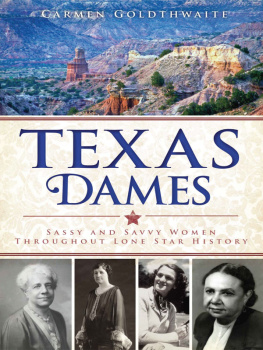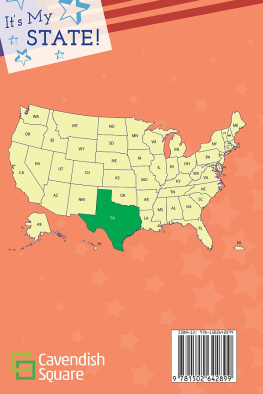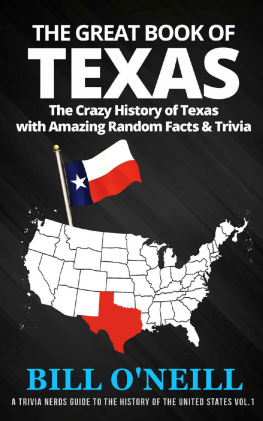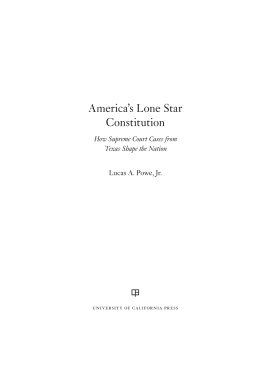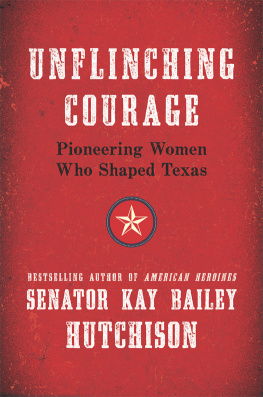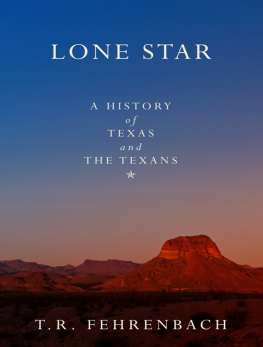
Published by The History Press
Charleston, SC 29403
www.historypress.net
Copyright 2012 by Carmen Goldthwaite
All rights reserved
University of Oklahoma Libraries, Rose 450
Front cover: The Palo Duro Canyon, Spanish for "hardwood." Today, it is Palo Duro Canyon State Park. Photo Courtesy Earl Nottingham, Texas Parks and Wildlife 2012
Unless otherwise noted, images appear courtesy of the author.
First published 2012
e-book edition 2012
Manufactured in the United States
ISBN 978.1.61423.709.9
Library of Congress CIP data applied for.
print ISBN 978.1.60949.812.2
Notice: The information in this book is true and complete to the best of our knowledge. It is offered without guarantee on the part of the author or The History Press. The author and The History Press disclaim all liability in connection with the use of this book.
All rights reserved. No part of this book may be reproduced or transmitted in any form whatsoever without prior written permission from the publisher except in the case of brief quotations embodied in critical articles and reviews.
Texas Dames and its stories of gallant Texas women is dedicated to the two Texas women who made it possible.
To my mother, Texas native Kathryn Fitch Goldthwaite, who reared me with boundless love and laughter and inspired me with stories of family, creating vivid pictures of resiliency, strength, courage and the good humor of Texas women. She fed the curiosity that led to these stories.
To dear friend SJ Mackenzie, who arrived in Texas this generation, my first reader, who tended the home front and ageing family so that I could trek the highways and byways of Texas gathering these stories.
CONTENTS
PREFACE
Across the sandy plains and hills of Texas, through the timber and the forests, the rocky hills and mountains and the grassy reaches, Texas women stamped their imprint. Maybe we know them. Maybe we dont.
But thats what Texas Dames: Savvy and Sassy Women Throughout Lone Star History is here to showtheir lives and their legacymuch of what todays Texas woman enjoys without question. But we werent there when Spanish and Indian women greeted and welcomed the Europeans or when Mexican women wielded their wealth from ranches to support the Texas independence cause.
We were not there when immigrants, only some of them literate, waded ashore to further the dream of owning land of their own. On the heels of that dream rose the zeal to educate their young and provide a faith that would hold them steady on lifes course.
We were not there when women performed heroic deeds to save a community or a child. Nor were we there when women who were shunned took up residence with the respectable folk and left their mark on the gaming tables, soldiers camps and mule trains of Confederate contraband cotton. Some were heroines. Others wore the crown of shady ladies. Some started life in Texas with sullied reputations and grew into renowned women. More than one was a spy. But nearly all exhibited similar strands of courage and determination to wrest a country, a state and a region from the wilds.
These are the Texas Dames, women who sallied forth commanding great ranches, building towns, directing banks, controlling bridges and operating mercantile centers. These Dames broke gender and racial barriers in education, ministry, banking and commerce, entertainment, the arts, athletics, politics and medicine.
Todays stars of stage, screen and pen might well trace their artistic roots to these Texas Dames. Todays Olympians continue to advance womens athletics based on the initial accomplishments of a little tomboy from Port Arthur and Beaumont. Todays astronauts fly higher and faster in the military and in civilian life, an acceptance built on the gutsy gals of San Antonio who would teach World War I aviators and fly the U.S. mail but could not join the army, a fact tempered only mildly by the WASPS of World War II. These women flew and helped the fellows train but did not participate in the spoils of victorious war until most were in their seventies and eighties.
Women today populate the U.S. Senate and the House of Representatives. They wield the gavel in legislative halls, courtrooms and municipal chambers. But long before them, before women won the right to vote, a doctors wife from Marble Falls won the reins of city government.
Just as todays Texas woman enjoys the pathways cleared of many brambles by these Texas Dames, this scribe owes much to the research and the writings of other female Texas writers and historians, such as Lou Halsell Rodenberger and Sylvia Ann Grider in Texas Women Writers. Others include Jo Ella Powell Exley, in Texas Tears and Texas Sunshine, and Sheila McElroy, in Red River Women. These and many more have been bringing to light the long dimmed stories of Texas Dames and their legacies.
And then, in conversations with friends, family, neighbors, caf owners and community historians and leaders, many other stories of these Dames were brought to light. For countless others who left a silent record, the courthouse documents of wills and land transactions served as sources of information and evidence of their lives. The research of folklorists and historians has also contributed to the tales of the Dames. Newspapers, both old and new, offered other stories, as have the historical societies and publications from around the state.
To these well-known and little-known womenthe Texas Dameswe owe a debt of gratitude for weaving the textile of Texas into the society we know today. When you read the stories of these Dames, pause with me and wonder what life would be like today without the mothers, grandmothers, great-grandmothers and so on who have pulled together families and communities and who have broken trails into disciplines once barred to women.
Here are their stories, from early Tejas to the mid-twentieth century.
ACKNOWLEDGEMENTS
No work of this nature is carried out alone. Librarians and archivists as well as museum directors and curators across the state lent time and talent in the pursuit of obscure facts and people. My thanks to them is boundless. First on the list would be the fine womenTammy Schrecengost and Nancy Raneyof the Heritage Museum in Big Spring, who introduced me to the first woman I researched through papers, photographs, the ranch and interviews with people who had stories to share.
Volunteers at the Falls on the Colorado Museum guided me to an amazing first in the nation story. W.L. Pate of the Babe Didrickson Zaharias museum walked me through the life of this preeminent golfer and female athlete. Newspaper editors in communities across the state provided good leads on gallant women of their areas. In Brownwood, word of mouth from the library to the newspaper to the Brown County Museum of History put me in touch with Alexia Hueske Bieniek, who had researched and written about this towns uncommon woman and was willing to share.
In my hometown, Shirley Apley, retired senior librarian of the Fort Worth Public Library, Genealogy/History Department, never seemed to tire of tracking down the stories of women in North Central Texas. Southern Methodist University (SMU)s DeGolyer Library came through with photos and stories of a Dallas legend.
Brenda McClurkin, historical manuscripts archivist at the University of Texas at Arlington Special Collections library, possesses an uncanny memory for names and research projects and called when something of interest turned up.
To each and all, a hearty thank you for your excitement and your diligence.
Next page
